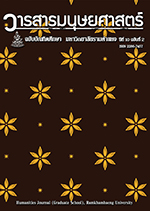Process of Building Resilience: A case study of Pretty girls Who had Experienced Stigma on their Occupation
Keywords:
process of resilience, pretty girls had stigmatized, occupational stigmaAbstract
Abstract
The research aims to study the process of building resilience and factors that promote resilience with a focus on pretty girls who were stigmatized by their occupation. This study employed case study in qualitative research, purposive sampling, inclusion criteria is over 20 years old and experienced stigma based on their occupation, qualified for the experienced stigma and growing phase checklist, has all of the required criteria, passing the assessment from of Resilience Inventory in higher levels, or has a everage above 3.51, which were performed until the saturation of the data by in-depth interviews method, included eight pretty girls.
The participants had experienced stigma based on their occupation, which could lead by negative stereotypes from the media about the ‘pretty’ occupation, which is not recognized by society and the devaluation of the occupation itself.
The research of processing of resilience resulted in the following six dimensions: (1) optimistic behavior by confidants; (2) positive mindset when facing issues; (3) a can-do attitude to manage problems; (4) learning from past failures and mistakes; (5) positive aspects of occupations; and (6) expectation of succession in their occupation. There were specific details in the context of pretty girls were stigmatized and the process was found to be analyzed in the congruence of concepts theories and related research.





 Contact: Miss Wanvisa Phonkayun (Aim) Tel:
Contact: Miss Wanvisa Phonkayun (Aim) Tel: 
